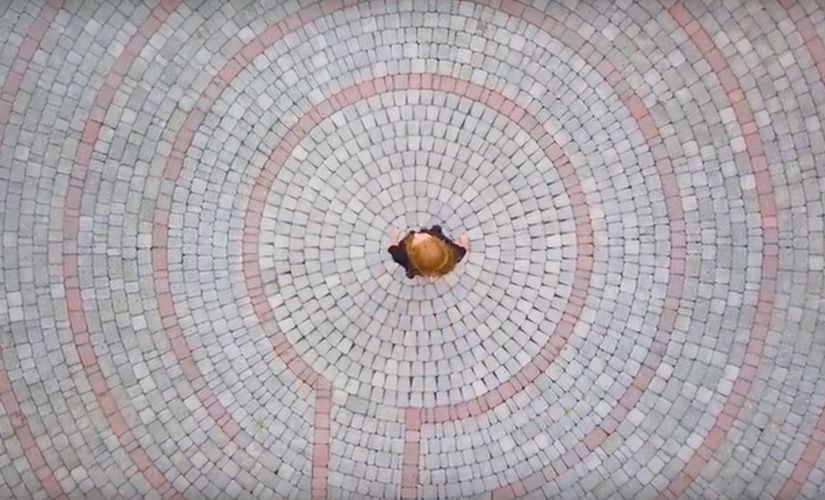The light slants on smooth marble. The room is still. Everything has been cleared, even the hard pews and baptismal font, those familiar markers of corporate worship. An elaborate pattern is laid out in front of me, taking up the majority of the floor. In twists and turns, it traces a path in concentric circles to its center.
I stand at the labyrinth’s entrance and contemplate my journey. I have arrived at this place, bringing with me the experiences of my day, week, year. Now I am ready to walk forward, one foot in front of the other, slowly reflecting on God’s presence with me.
What is a Prayer Labyrinth?
Labyrinths go back as far as the Greek myth of the minotaur, where one imprisoned the monstrous creature whose bull head symbolized human reason driven by unmanageable passions. But the first evidence of their use by Christians dates to the fourth century in North Africa. Rather than a cage to contain the unknown or unwelcome parts of ourselves, Christian labyrinths are designed to help us invite God into every aspect of our lives. They help us focus on our ultimate goal of living with Christ, in union with God.
Chartres Cathedral in France is often cited as the most notable historical example. Its labyrinth was mapped out on the cathedral’s floor and gave people the opportunity to take a symbolic pilgrimage to Jerusalem. Participants underwent a similar process of transformation as those making the far more difficult journey to the Holy Land. While these pilgrims didn’t physically walk where Jesus walked, they walked with Jesus on their own sacred path.
Prayer labyrinths give us a physical process for seeking deeper intimacy with God, classically by directing our steps to follow eleven circles and four quadrants of a pattern. The journey is marked by three stages. The first stage, purgation, is the process of releasing cares, distractions, and worries while walking towards the center. The second stage, illumination, is when the pilgrim reaches the center. The pilgrim stops to pray and meditate, receiving whatever God has for them. The final stage, union, begins when the pilgrim walks away from the center. They reflect on their experience and prepare to carry out this deeper intimacy with God as they re-enter their daily lives.
This spiritual practice has increased in popularity again as the world has become more hurried and fragmented. It offers a way to slow down and spend time with God, to quiet your mind and attune your body to what is more enduring. Today labyrinths can be found inside on church floors or outside in gardens, offering people a way to journey with God and find greater calm and integration.
Journeying to the Center
Now I embark on my own pilgrimage, leaving the hurry of my day to seek God’s promised peace. I pace my steps, paying careful attention to the placement of my feet. My breathing begins to align with the movement of my body. I walk a short stretch, then follow the path to the left, then to the right. The middle seems to be far off, but I am glad. The distance gives me time to settle into my journey.
I quickly discover that the pattern structures my thinking, helping me focus. Everything belongs in the safety of God’s presence, even my thoughts, worries, and frustrations. Nothing is out of reach of God’s love. This is a place to acknowledge the things that I carry, not hide them. The labyrinth’s measured space helps me contain my experiences and feelings—putting them in order. Giving me time to explore them at leisure. Moving me towards deeper acceptance, so I can release what isn’t mine to carry.
As I walk, I invite Jesus to join me. I start to meditate on his encouragement in Scripture: “Peace is what I leave with you; it is my own peace that I give you. I do not give as the world does. Do not be worried and upset; do not be afraid” (John 14:27).
Do not be worried. Do not be afraid. Peace I leave you. I turn over the words in my mind with each step forward. As the labyrinth’s center comes into focus, I realize Jesus’s promises are becoming an easy load to carry. I am not as burdened by my thoughts or internal struggles. I have journeyed to a place of greater honesty with myself and a greater recognition of God with me.
A Labyrinth State of Mind
As I leave the center, I begin to walk back in a changed state of mind. My thoughts are quieter, less distracted. I am beginning to rest in the peace Jesus has given me, making my departure equally as important as my arrival. As I move towards what is ahead of me in the world of my responsibilities and joys, I practice being present here with God. As with other modes of meditation, I spend time with Jesus’s words and welcome his peace deeper inside me. It is now a grace to which I can return at any time.
Try embarking on your own pilgrimage towards deeper intimacy with God. This could be in a physical labyrinth, or practicing a labyrinth state of mind while walking through your neighborhood. You might also try printing out a labyrinth pattern and tracing it slowly with your finger. Meditate on these verses to focus on God’s presence with you as you take each step:
- “Your life is a journey you must travel with a deep consciousness of God” (1 Peter 1:17b MSG).
- “Your word is a lamp to guide me and a light for my path” (Psalm 119:105).
- “Come to me, all of you who are tired from carrying heavy loads, and I will give you rest” (Matthew 11:28).
- “Remember the LORD in everything you do, and he will show you the right way” (Proverbs 3:6).
Read more posts about: Spiritual Practices
Thanks to the support of our faithful financial partners, American Bible Society has been engaging people with the life-changing message of God’s Word for more than 200 years.
Help us share God's Word where
needed most.
Sign up to receive Bible-reading tips, tools and resources.




